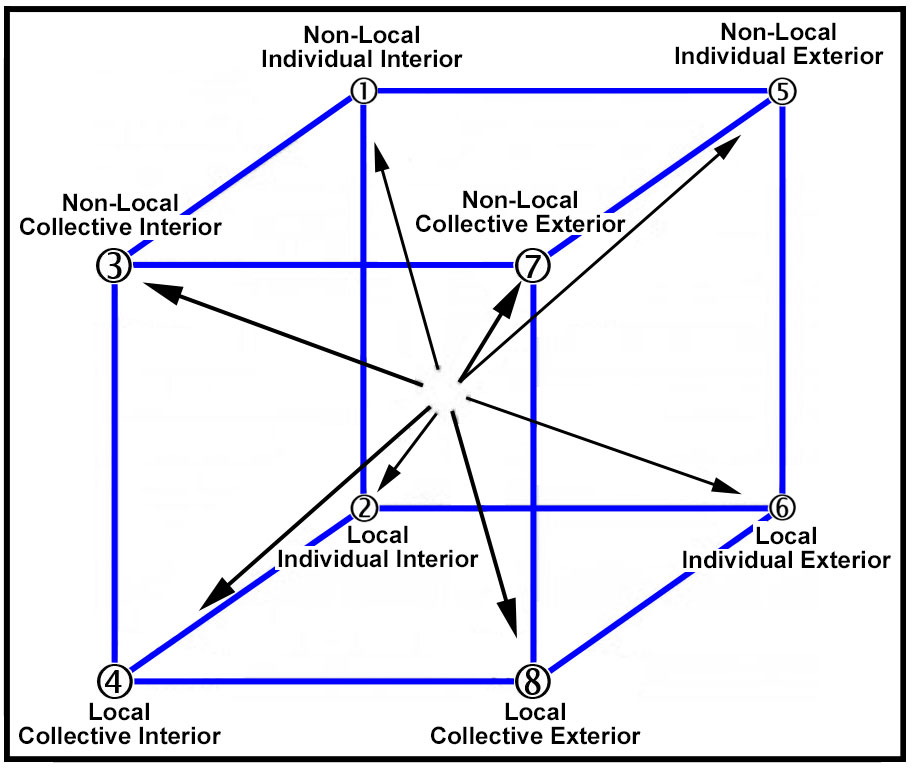AQAL AQAL is an acronym, created by Ken Wilber, meaning All Quadrants, All Levels (Sex, Ecology, Spirituality: The Spirit of Evolution, 1995). According to Integral
Theory, there are at least 4 primary dimensions or perspectives (‘Quads’) through which we can
experience the world in addition to mapping out ontologies,
epistemologies
and truth claims.
Consciousness is simply divided into two great domains: individual (personal) and collective. Each domain
divides into two sub-domains: Subjective (interior) and Objective (exterior). Individual: Subjective & Objective Collective: Inter-objective & Inter-subjective Integral Theory views reality as composed of ‘holons’ or a holarchy structure consisting of wholes and parts where wholes are parts of other wholes. For example, atoms are parts of whole molecules, which are parts of whole cells, which are parts of whole organisms, and so on. In addition to the physical domain, holarchies are also found in the social and formal sciences – from pragmatism to structuralism to linguistics to information theory to computer programming. A level, similar to the term ‘stage’, represents a level of organization or a level of complexity. Complexities, such as the 3-level models of moral developement, ‘bodies’ (gross, subtle, causal), or the 'Great Chain of Being' (body, mind, Spirit), can be visually represented in one of AQAL’s 4 quadrants.
THE INDIVIDUAL THE
COLLECTIVE Many scholars have written that the AQAL integral model is a fine overview and summary. American philosopher Christian de Quincey comments: “Perhaps other than Kant and Hegel, no one has presented a comparable comprehensive framework for integrating the 'three cultures' of science, morality, and art. More than any other individual, [Wilber] has pieced together a truly remarkable map of the mind". Because of its inclusiveness and its charitable integration of all the four aspects, AQAL is one of the best attempts to unravel the world-knot problem (about relating higher and lower interior levels, about how reason and feelings or emotions are related). AQAL
Cube
Upon his introduction of the AQAL Cube Wilber received 'Holy Hell' from many Integral traditionalists for introducing an additional “Inside/Outside” polarity that could not be empirically accounted for. Quantum Consciousness, the “bad boy” of Quantum Theory, has been criticized as a pseudoscientific movement that assigns supernatural characteristics to various quantum phenomena such as non-locality and the observer effect. Likewise, critics of the “AQAL Cube” call it the “bad boy” of Integral Theory. Proponents of AQAL Cube observe that ‘AQAL Square’ appears to flatland the Material/Physical with the Non-Material in both the Upper Left and Right Quadrants. The underlying problem still remains unanswered: What is Non-Material Consciousness that can be differentiated from Matter/Mind as equally as AQAL Cube? Sidenote: maps are indispensable tools for exploring a ‘territory’, whether physical,
mental-emotional or spiritual. It’s important not to get confused with the map’s symbols and the ‘actual’
territory. Such confusion is like ‘trying to drive up the signpost!’ (phrase from Alan
Watts). z |

